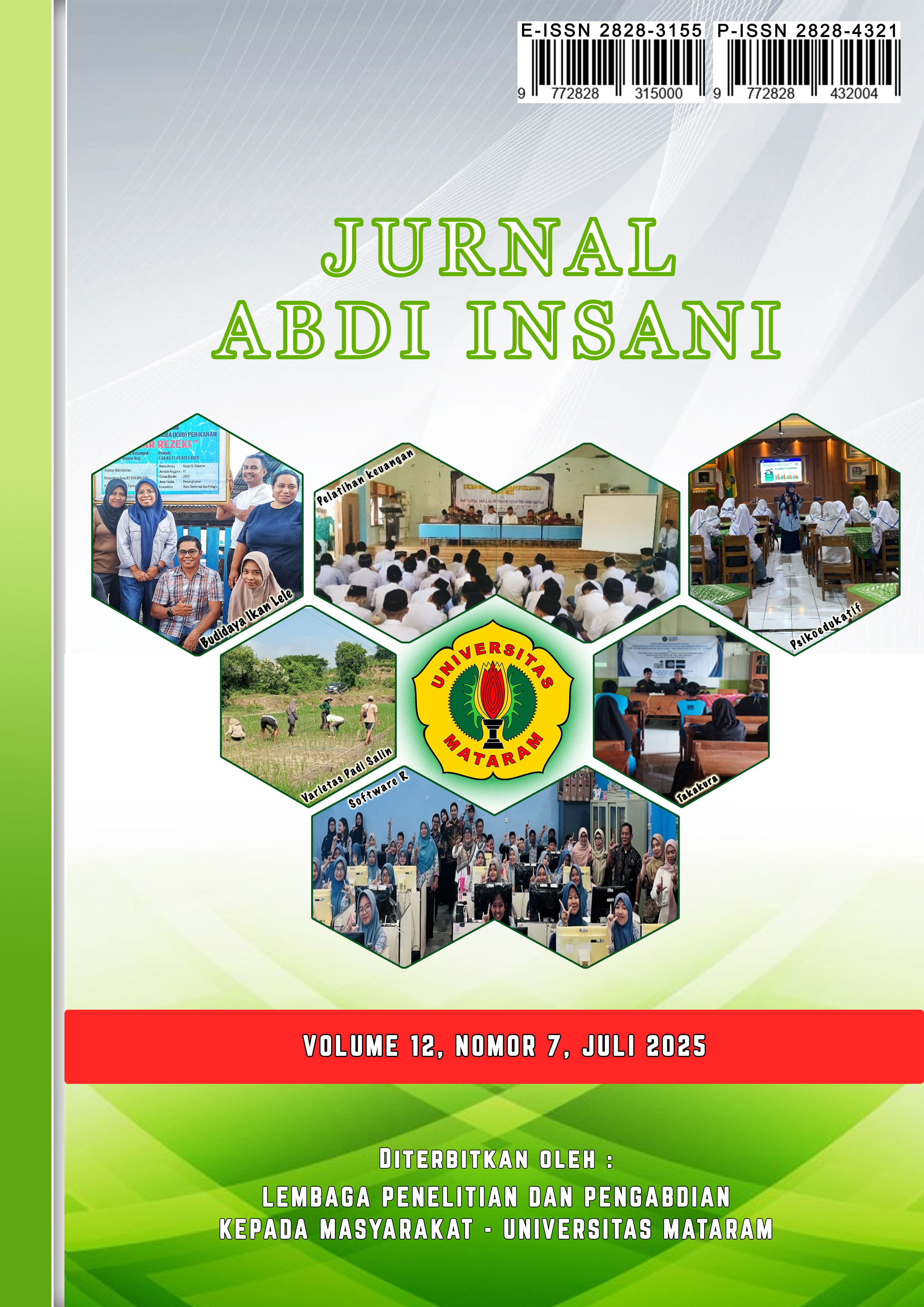SOSIALISASI DAN PEMBENTUKAN PEER EDUCATOR REMAJA PUTRI SEBAGAI UPAYA MENANGGULANGI ANEMIA DI DESA SUNGAI TABUK KERAMAT
DOI:
https://doi.org/10.29303/abdiinsani.v12i7.2640Keywords:
anemia, adolescent girls, iron supplementation tablets, peer educator, socializationAbstract
Anemia is a serious health issue among adolescent girls, with one of the main causes being the low intake of iron supplements (Tablet Tambah Darah/TTD). In South Kalimantan, the prevalence of anemia in adolescent girls reaches 53.3%, yet TTD consumption coverage remains low. In Sungai Tabuk Keramat Village, 56.7% of adolescent girls had not received TTD in the past year. This community service program aimed to increase knowledge and compliance with TTD intake through the establishment of peer educators. Activities included health education, training on the use of hemoglobin (Hb) measuring devices, peer educator development, and 2.5 months of monitoring. The results showed that 92% of participants improved their knowledge of Hb device usage, and 92% of those re-tested achieved normal Hb levels. Monitoring of TTD consumption recorded that 31.6% of adolescents adhered to recommended intake in August, but this declined to 15.8% in September. This program proved effective in enhancing knowledge and hemoglobin levels among adolescent girls and demonstrated that peer educators can serve as effective educational agents. However, maintaining long-term adherence to TTD intake remains a challenge. Therefore, continuous support, increased involvement of families and health cadres, and strengthened monitoring systems are essential to sustain the program’s impact and contribute significantly to anemia prevention among adolescent girls.
Downloads
References
Apriningsih. (2023). Anemia pada remaja putri: Perspektif sosio ekologi. Syiah Kuala University Press.
Astuti, D., & Kulsum, U. (2020). Pola menstruasi dengan terjadinya anemia pada remaja putri. Jurnal
Ilmu Keperawatan dan Kebidanan, 11(2), 314–327.
Aulya, Y., Siauta, J. A., & Nizmadilla, Y. (2022). Analisis anemia pada remaja putri. Jurnal Penelitian
Perawat Profesional, 4(4), 1377–1386.
Fakhriyah, F., Isnaini, I., Noor, M. S., Putri, A. O., Fitriani, L., Abdurrahman, M. H., & Qadrinnisa, R.
(2021). Edukasi remaja sadar gizi untuk pencegahan kekurangan energi. SELAPARANG, 5(1), 499–
Fitriana, F., & Dwi Pramardika, D. (2019). Evaluasi program tablet tambah darah pada remaja putri.
Media Publikasi Promosi Kesehatan Indonesia (MPPKI), 2(3), 200–207.
Harianti, R., Nurjanah, T., & Hasrianto, N. (2022). Peer education as a method in sexual, reproductive
health promotion and risk communication for adolescent. Jurnal Kajian Komunikasi, 9(2), 213–
Indrawatiningsih, Y., Hamid, S. A., Sari, E. P., & Listiono, H. (2021). Faktor-faktor yang mempengaruhi
terjadinya anemia pada remaja putri. Jurnal Ilmiah Universitas Batanghari Jambi, 21(1), 331.
Kemenkes RI. (2014). Peraturan Menteri Kesehatan Republik Indonesia Nomor 88 Tahun 2014 tentang
standar tablet tambah darah bagi wanita usia subur dan ibu hamil. Kementerian Kesehatan
Republik Indonesia.
Kemenkes RI. (2023). Survei Kesehatan Indonesia (SKI) dalam angka. Kementerian Kesehatan Republik
Indonesia.
Khobibah, Nurhidayati, T., Ruspita, M., & Astyandini, B. (2021). Anemia remaja dan kesehatan
reproduksi. Jurnal Pengabdian Masyarakat Kebidanan, 3(2), 11–17.
Nasruddin, H., Faisal Syamsu, R., & Permatasari, D. (2021). Angka kejadian anemia pada remaja di
Indonesia. Cerdika: Jurnal Ilmiah Indonesia, 1(4), 357–364.
Simatupang, S., & Widiyarti, S. H. (2024). Efektivitas pemberian tablet tambah darah terhadap anemia
remaja di SMPN 1 Parongpong. MAHESA: Malahayati Health Student Journal, 4(4), 1567–1576.
Suryati, E., Bastian, B., & Sari, I. (2021). Perbedaan kadar hemoglobin menggunakan metode cyanide-
free dan POCT pada ibu hamil. Anakes: Jurnal Ilmiah Analis Kesehatan, 7(2), 123–132.
Tim Percepatan Penurunan Stunting. (2023). Laporan percepatan penurunan stunting semester II
tahun 2023.
Wahyudi, H. (2024). Pengantar statistik parametrik dan non (dalam kasus). PT. Kimshafi Alung Cipta.




















